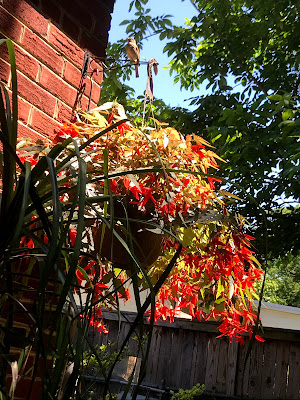I've had more food from my garden already this year than in many previous years. I had lovely lettuce and arugula, planted from seed, in a single large pot. The lettuce has been less slug/bug/rabbit eaten than other lettuce I've tried recently. I finished it up, and ripped it all out by the roots, this weekend. I've put a tomato plant in the same pot, and moved the pot into more sun.

My big harvest this week was broccoli! I planted six plants from Home Depot back in March. By just dumb luck, the deer didn't come by before I got around to putting up the netting recently, and the plants got BIG! I've never successfully harvested broccoli before. I watched the big center heads get bigger and bigger, and worried about when to harvest. I got the first couple of clumps early last week - probably about 5-6 inches across each. That's a lot of broccoli! But then I realized the other four heads were about to flower, so I went for it big time! In fact, I should have picked them a couple of days earlier.
One way I fix cauliflower that makes it disappear quickly is to roast it, and I discovered this roast broccoli recipe from Jose Andres in one of my new cookbooks. Basically, you cut off the stems (reserving for another use) and roast the florets with slivers of garlic and a generous amount of olive oil. Truly, stupid-easy, and truly delicious!
Yesterday, I finished the last of the roasted broccoli in a salad with the last of my own lettuces. I'm finding I can overeat on vegetables - I define "overeating" as eating past the point of optimal fullness, to stuffed. Things could be worse, I suppose. I haven't had a serious ice cream attack in days.
Today, I had the well-cooked broccoli stems with rice, onions, and parmesan cheese in my own version of comfort food. It'll be a while before there is another harvest, though the broccoli plants may produce some viable small side shoot florets. I've got onions, chard, cucumber, zucchini, and two kinds of beans coming along, as well as two small tomato plants in pots. It's been a good summer for growing, so far. Sun, rain, and not too much humidity. The rotating of crops and fertilizing is also helping, I bet.













